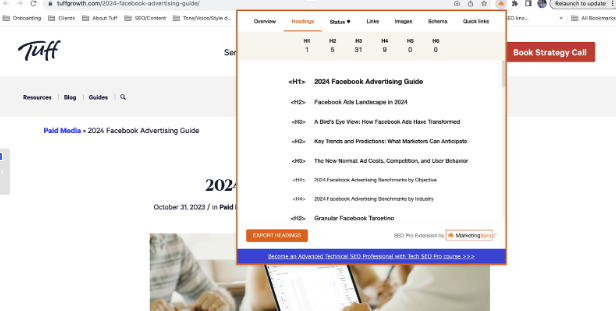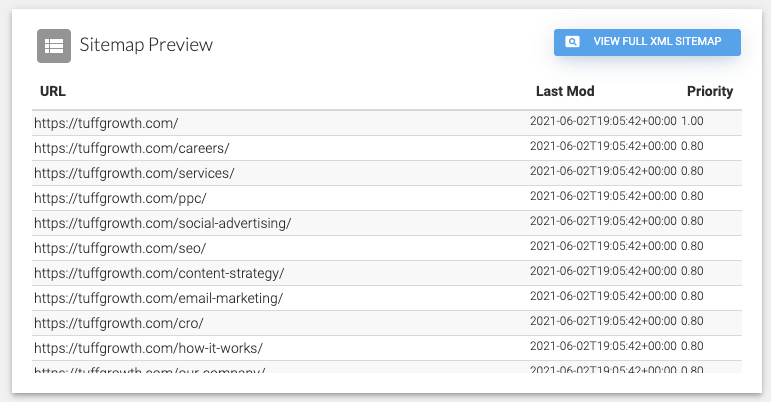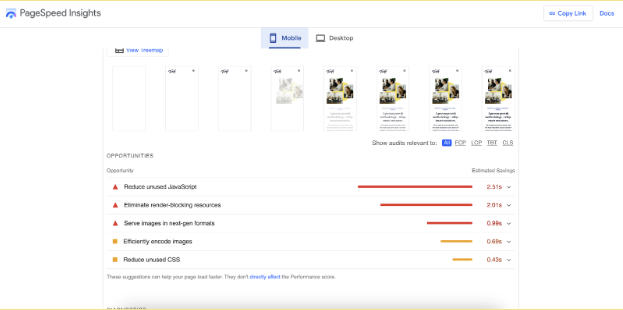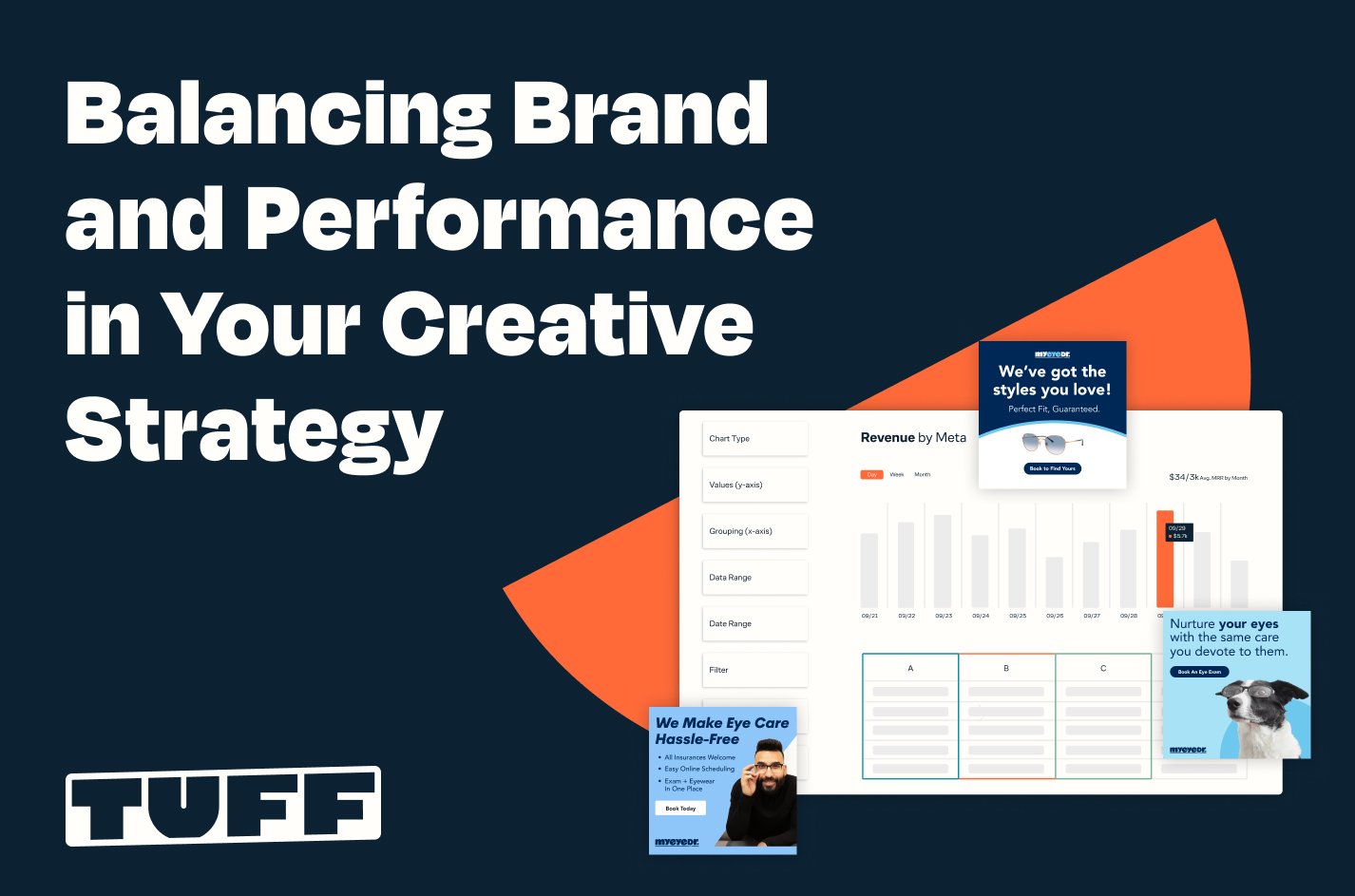The Difference Between On-Page, Off-Page, and Technical SEO [Updated]
Author’s Note: We’ve given this blog post a refresh on November 2, 2023, complete with fresh information, new links, relevant data, and more.
If you want to increase your site’s search traffic while building an inbound pipeline of potential customers, then Search Engine Optimization (SEO) is a channel you need to explore. Prioritizing SEO increases the chances of customers finding your website on the search engine results page (SERP) when searching for keywords related to your products or services. According to databox, 70% of marketers find SEO more effective at driving sales. And if that wasn’t enough, compared to other tactics like Pay Per Click (PPC), SEO is cheaper.
At Tuff, with technical SEO agency experience, we analyze various facets of our clients’ websites—from homepage to blog, and from site speed tags to 404 redirects—to discover what SEO tactics will positively impact their growth.
What is on-page SEO?
On-page or on-site SEO is the process of optimizing specific elements of your website’s pages, such as content, title and meta tags, and HTML subheadings, for both humans and search bots alike to improve your site’s visibility. On-page SEO encompasses all the improvements you make directly to a web page to improve its visibility on the search engine results pages. Some examples of these include:
- Writing helpful, quality content
- Including descriptive title tags and meta descriptions
- Adding both internal and external links with relevant anchor text
These optimizations help search engines like Google and Bing (if you’re into that, we don’t judge), interpret page content to understand what it’s about. When the search engines understand the purpose of your page, they can turn around and help visitors searching for the goods or services you sell to find you.
Remember: search intent is crucial here. When you create content that matches the true intent behind a user’s search—whether informational, navigational, or transactional—you better position your webpage to rank highly on the SERP. Another way to think of on-page SEO is as a collection of signals search engines use to decide whether to serve your content in response to a given query. The more finely tuned your on-page elements are—and the more useful your page is to readers overall—the more likely you are to rank highly.
So, how can you leverage those signals to create good on-page SEO? Here are some things to consider.
Use keywords thoughtfully
In the good ol’ days of SEO, you could have articles filled with search terms for your industry. So if you were a dog food company, most of your web pages would be jam-packed with search terms like “best dog food,” “top-rated dog food,” “number one dog food,” etc. This was great for search engines, but terrible for people that had to read sentences like “Have you asked yourself, ‘Is there dog food near me?” Now, spamming a target keyword in your content is much more harmful than helpful.
On-page SEO is about using relevant, targeted keywords to help your site rank higher. But it’s not just going into Semrush and picking the top-ranking keywords. There’s a technique to it. First, you want to perform a SEO competitive analysis, in which you determine the top keywords for your industry and how your competitors rank for these as well. Plus, you want to look for relevant keywords with low competition. This will help your site build out its expertise and authority, which should have Google start ranking your content higher in the SERPs if your content is deemed valuable to the end-user. So tl;dr:
- Identify your competitors and compare your keywords
- Determine how the customers you want search for your goods or services; i.e., their search intent
- Research successful pieces of content in your space and determine how they utilized keyword phrases
- Use online SEO tools like Semrush and Google Search Console to look for keyword opportunities and evaluate the performance of your top search queries and keywords
Optimize your page title tags and HTML heading tags
Every piece of content you produce should have a compelling title tag that informs what the article should be about and contain the primary keyword you want to rank for. Neither Google or users have a lot of time, so if you can tell them what they can expect from the web page in the most concise way possible, you’ll be rewarded. Research shows that page title tags are also confirmed ranking factors, so ignore them at your own peril.
HTML heading tags are also a great way to add your primary and secondary keywords. So if you were writing a piece on say, different types of SEO, your structure would look like this:
- H1: The Difference Between On-Page, Off-Page, and Technical SEO
- H2: What is On-Page SEO?
- H3: Title tags
And so on.
In the below example from another Tuff blog, we used the SEO Pro Chrome Extension to illustrate the layout of heading tags on the page.
Search engines can crawl the page title and headings to help them determine what the content is about, and for a user, it is an excellent way for them to skim the content and get to the answer they want. All that engagement will go a long way toward boosting your visitor site time and click-through rate, which will, in turn, increase your organic growth.
Remember: when it comes to on-page SEO, what’s good for the user is good for the search engine. So use title and heading tags to satisfy the needs of both.
Write helpful, useful content
One thing people get wrong when doing on-page SEO? They create content for the explicit purpose of ranking highly. In other words, they prioritize writing for Google over human readers.
As we point out above, in SEO, this sort of approach was once par for the course. But in 2023, Google is actively deprioritizing content like this. Case in point? Google’s September 2023 Helpful Content Update specifically targeted “content that seems to have been primarily created for ranking well in search engines rather than to help or inform people.”
The solution? Writing helpful, useful content that answers your readers questions comprehensively. Fortunately, Google has released plenty of documentation to clue you in on what exactly this sort of content looks like—the quality rater guidelines.
These guidelines are used by Google search quality evaluators to gut-check the ability of its search algorithm to rank content that’s helpful to human readers.
So if you’re looking to create helpful content, start by reviewing Google’s own documentation. You can reference an acronym, E.E.A.T, to assess how effectively your content is ticking off Google’s boxes:
- Experience — Does the content speak from a place of personal experience, or is it more concerned with the experiences of other people? For Google, harvesting a unique, original perspective is one of the hallmarks of quality content.
- Expertise — Does the author of the content draw on their own expertise in a certain field to inform their opinions? This is especially important in YMYL—i.e., Your Money or Your Life—fields, such as personal finance, medicine, and health-related topics. But the principle applies for all written content. In other words, whether you’re writing about accounting, growth marketing, or credit card reward programs, it’s best to find an author with significant expertise in those areas for your blog post.
- Authority — This one is related to expertise. It follows that if you have significant expertise in a subject, you can write about it from a place of authority. You can also think about authority as comprehensiveness. If you want your work to be seen as authoritative, it should dispassionately address a topic from all angles, without omitting facts to mislead an audience.
- Trustworthiness — Similar to the above ideas, this final point highlights the face that the content you produce should be trustworthy. Content that promotes misinformation, willfully deceives, or cuts corners just isn’t going to cut it.
Also important for 2023—AI-generated content is now fair game. Google’s documentation specifies that quality content should be rewarded, even if it’s produced by ChatGPT or a similar tool. The key point here is that it must be quality. So, if you’re going to rely on AI to do the actual writing, you better have a solid human editor to make sure your content’s up to snuff.
Include an SEO-friendly URL
This one often gets overlooked. But the title should be a simplified summary of what your page is about. It may be tempting to just go with an auto-generated URL, like the ones Shopify and WordPress suggest based on your content, but take a minute to think about it. If you can remove any filler words and ensure that your title contains your primary and target keywords, you’ll have a greater opportunity to rank higher in the SERPs. So in short, make sure you:
- Exclude words that don’t add significance to the URL
- Add relevant target keywords
- Make it easily readable
- Use hyphens and underscores
- Needs to contain your single domain and subdomain
- Match URLs with your content’s page titles as closely as possible
In the end, your URL will look something like this:
https://tuffgrowth.com/seo-competitive-analysis/
Write optimized Meta Tags
Meta elements are also crucial for on-page optimization. So, don’t just go with the auto-generated meta tags from a CMS platform. As Google likes to tell us, you know your content best. So you take a moment to craft meta titles and meta descriptions that stand out from your competitors and use those valuable keywords.
Google typically displays the first 50-60 characters of your title and 155 characters of your meta description. This includes spaces, so you don’t have a lot of room to work with. Let’s drag out our dog food example again. For a page on our made-up Pawsome Dog Food company, we want to tell both the search engines and the reader what it’s about while also encouraging them to click. So it should look something like this:
Optimize Images
Are images important for on-page SEO? They sure seem to be. According to an article in HubSpot, articles with images get 94% more total views than articles without images. But just like the keywords, the images have to be relevant to the content, and you have to do some on-page optimization to make the images work a little harder for you. This means titling the images using your keywords if possible and adding Alt-text that uses your keywords so the search engines can better categorize the content.
That was a lot, and there are tons of tweaks and on-page SEO strategies you can implement to make your growth strategy successful. But now we need to discuss off-page and technical SEO, and how they can also be an important part of your company’s organic growth.
Add internal links
Finally, add relevant internal links between the pages on your website to follow best practices for on-page SEO and help serve additional content to interested readers.
Search engines crawl links on your website to find new pages. So by including internal links between multiple pages on your website, you help Google navigate it more easily. Internal links also leave those same crawlers important clues as to your site structure by signaling which pages on your website are most important. When your core product or service landing pages have an army of internal links pointing back at them, search engines can infer the relative importance of that page compared to others.
But let’s not forget the user in all of this! As we mentioned above, Google and other search engines have developed to the point that what’s good for the search engine is often good for the user, and vice versa. By sprinkling relevant internal links throughout your content, you can help visitors to your site more easily access other pages and sections of your site of interest to them.
The above is enough to give you a solid foundation in on-page SEO tactics and best practices. But what about optimizations you can make to your content off of the page? For that, we have off-page SEO.
What is off-page SEO?
Off-page SEO includes any sort of tactic off of the page itself to bolster its search engine rankings.
Typically, we think of off-page signals as those referring back to your site, such as social media mentions, backlinks from external domains, or anything that happens off your site that influences your site’s authority. Off-page
SEO work generally falls under the Social Media Manager, or Link Building Manager, or Off-Page SEO Manager role at your company.
Let’s review some of the most common off-page factors and tactics for improving off-page SEO for your website.
Acquire backlinks
The most common off-page SEO tactic is link building. In the earlier days of search, SEO strategies determined if a page outside of your website linked back to your site, creating a backlink, that it was a signal of the popularity of your content. The more backlinks you had, the higher you would rank. In addition, you got bonus points if the other sites linking back to you were also popular. So, there was a mad dash of websites linking to each other as much as possible.
But like that judgemental principle in your middle school, Google judges your site by the company you keep. So if you have too many backlinks that are considered “toxic,” meaning they have a low domain authority or are from just terribly spammy sites, a backlink from these types of sites could actually hurt your on-page SEO. This means you have to be careful who you request a backlink from.
A big part of off-page SEO is curating your backlinks. Often, you can’t control who links back to your site. In this instance, you have to disavow these toxic backlinks. Plus, you could have sites linking to web pages that no longer exist on your site. This would require a link reclamation campaign.
There are several different ways to acquire backlinks from reputable sites. We’ll explore a bit more below how creating attention-grabbing content is one of the best ways to do so. But you can also do manual backlink acquisitions by emailing or reaching out to site owners or blog editors directly. By opening a line of communication with these stakeholders, you can suggest placing a link back to your content in a way that elevates the quality of the other site’s content.
Create content people want to reference
An enterprising content marketing manager should know how to tap into their company’s resources to create content that generates citations naturally around the web.
For starters, the leadership in your company probably would consider themselves experts in their fields. Tapping into your own company’s subject-matter expertise to produce thought leadership content is a great way to acquire backlinks the good ol’ fashioned way. Youtube video that expresses a strong POV on an important issue, like the impact of AI on SEO.
Another way to do this is by sourcing meaningful data to produce clickable content. People love statistics, especially when they uncover trends in their own industry.
Sourcing data doesn’t have to be complicated, and it can come from a variety of sources. For starters, SaaS companies or other digital platforms might have access to user or platform data that tells an interesting story about user actions, behaviors, or similar. But even companies without user data can source data by running surveys and publishing the results.
Do guest posting or PR campaigns
Finally, another common off-page SEO tactic involves creating content on other websites that, in turn, link back to your own pages in a strategic way.
Remember the manual outreach approach for link building? Guest posts works similarly. If you know of a blog or website that shares a common audience to your own, you can reach out to the site owner and ask to contribute a blog of your own.
Different types of sites might be receptive to this approach than others. But you can increase your odds of a successful pitch by suggesting mutually beneficial content topics, hitting your deadline for submission, and incorporating the other website’s style guidelines and tone of voice into your contributed blog.
Another tactic involves running a PR campaign in established news outlets, PR newswires, or industry trade publications. There are different ways to accrue brand mentions and backlinks in so-called “earned media.”
Normally, you can tap into your network or partner with an external vendor with the connections to make this sort of exposure possible. While brand mentions don’t always necessarily include backlinks, they can still boost your website’s traffic via direct entrances or organic branded-searches.
Off-page SEO vs. on-page SEO
Comparing on-page vs. off-page SEO? In summary, on-page SEO refers to any optimizations you make to the content or structure of the pages on your website.
Off-page SEO addresses the ranking factors outside of the context of your website to bolster organic search visibility, including backlinks and brand mentions.
But that leaves one final area for us—technical SEO.
What is Technical SEO?
Technical SEO is a catch-all term for optimization improvements that are not on-or off-page. An SEO skilled in this will perform technical optimizations to your site to ensure you have a solid foundation for all your on-page and off-page SEO tactics. Their behind-the-scenes work can do wonders on your site’s performance and your organic growth. This is because Google not only rewards good content— it also values a good user experience. If your site is too slow, too hard to crawl, or you have too many dead links, all the great content in the world won’t get you to rank high in the SERPs.
So, is technical SEO important in the grand scheme of things?
At Tuff, we look into a client’s site health before we make any changes. We know that if the site’s foundation is bad, then all our work for the client won’t help them grow an inch. So technical SEO is just as important as any other SEO tactics, if not more important. So what should you address from the technical SEO standpoint? This isn’t the definitive list, but it’s some of the heavy-hitting a technical SEO will perform on a site.
Site Architecture
We mentioned how vital a good foundation was. An experienced SEO can use technical SEO tools to inspect your technical SEO health and ensure everything is working and linking as it is supposed to be.
Your site’s architecture makes it easy for search engines and users to find you. Crawlers need to be able to thoroughly and easily navigate your entire site. A website with an ideal architecture helps crawlers locate anything they’re looking for across all of your pages.
Another reason technical SEO can be so effective is that it flushes out any internal linking issues you may have, such as broken links. Internal linking to high-priority pages gives them greater authority (Remember that whole E.E.A.T. thing?) These high-priority pages are recognized by Google and receive a higher ranking, which is key for sites like your homepage.
It’s not just for search engines. A good site architecture also helps people find what they need more quickly and keeps them from bouncing too soon. Keeping customers happy lowers your bounce-back rate, which helps your organic rankings.
Sitemaps
Your site map or XML sitemap is really just what it sounds like. It’s a roadmap for search engines to explore your site. Just like any good map, an XML sitemap will highlight the most critical areas of your sites, like landmarks, so the search engine robots know what to check out first.
This is key for extensive sites where the crawlers may not know where to begin; you want to make sure that the search engines prioritize your most important pages, such as landing pages before your crawl budget is used up.
You can update your sitemap by submitting it to Google Search Console.
Mobile-first Optimization
With Google prioritizing mobile search over desktop, your site must be friendly for mobile devices. Technical SEO ensures your site not only looks great but functions as it should when someone accesses it from their phone or tablet.
If that doesn’t seem too important, consider that in 2023 mobile search accounted for 49.78% of all searches—nearly half. So yeah, a website’s overall mobile friendliness is a pretty big deal.
So, what should you consider when assessing the performance of your website on mobile? For starters, Google’s Core Web Vitals. One free tool you can use to assess this is Google’s Page Speed Insights, which examines core web vitals and other elements, such as page rendering and unused Javascript files, when determining the technical health of your own website for both mobile and web.
Duplicate Content
Some things are so important you feel the need to say them multiple times, but too much and Google will ding your rankings. A technical site audit will look into what pages constitute duplicate content—i.e., content with the same message or even the exact same content, and devise a plan on what to keep and what to throw out.
A technical SEO will also look into thin content or what pages are not providing much value from a search standpoint. Remember, Google will penalize you if you throw up a page that offers no value. Google doesn’t like it when you waste its or a user’s time. For large enterprise sites, chances are there are a lot of duplicate or thin pages, and a technical SEO can ferret these issues out to ensure your site is healthy.
Page Speed and site speed
Do you hate sitting in traffic? So does Google, and if your site loads too slow, more than two seconds, then Google is going to have something to say about it. But it’s not just search engines that have a problem with slow page speeds.
Most people will leave a site if it takes longer than three seconds to load. But, unfortunately, all this clicking-and-bouncing negatively affects your site rankings. There could be too many redirects, line breaks in your code, Javascript issues, image optimization issues, and more. So having a technical SEO that can determine why your page is loading too slowly can save your organic rankings..
Schema Markup
Schema markup or structured data is a type of code that communicates to Google how to follow your website and what the data on your site means. Rember, Google isn’t patient—it has a lot to do, so good communication with search engines is key to getting you to rank higher.
Schema markup provides details about your products, services, events, articles, reviews, and much more. This level of clarity makes it easier to comprehend your content’s context, making it more likely to appear in relevant Google search results.
Additionally, schema markup doesn’t just benefit search engines. It also enhances the user experience when viewing search results. Rich snippets, enabled by schema markup, provide users with quick, concise, and relevant information directly in the search results. This not only makes your website stand out but also increases the likelihood of attracting organic website traffic, as users are more likely to click on search results that provide instant, valuable information.
Orphan pages
Technical SEOs also uncover problems with the linking on your website. One of the most common problems involves orphan pages, or pages without any internal links back to other pages on your same site.
When search engine crawlers encounter such pages, they may not be able to access them easily from other parts of your site. This lack of interconnectedness can severely impact the indexation and ranking potential of these pages. If a page isn’t linked internally, search engines might not even know it exists, let alone consider it for ranking in search results. A technical SEO can concoct a plan to build links to any orphan pages or broken internal links on your site.
Finally, technical SEO also looks at how your site performs internationally, hreflang tags, and a host of their back-end issues such as canonicals, robots.txt or the robots meta tag (which can block search engines), and redirect chains, and assesses how any Google update may affect your site’s overall technical optimization.
What kind of SEO is best for your site?
The easy and lazy answer— all of them, and this is true. A holistic SEO strategy isn’t about on-page vs. off-page SEO. It should rely on all the strategies that affect your organic growth channels. But sometimes it’s not realistic to focus on all three. You may not have the expertise or the people to make a serious SEO- impact to grow your site’s organic channels.
This is where a growth marketing agency like Tuff comes in. We’ll do a deep dive on your site and determine which SEO tactics will have the biggest impact on your business. We’ll determine if on-page, off-page, or technical SEO is going to improve your conversions and website rankings and then come up with a plan and help you execute. Each business model is different, so there is not a one-size fits all approach. If there was, SEO would be easy. However, with a partner like Tuff on your team, on-page, off-page, and technical SEO are a whole lot easier.
If you want to know more about how on-page, off-page, and technical SEO can be a part of your growth marketing strategies, hit us up. We’d be happy to walk you through our game plan on how we can attract the right traffic to help make your business successful.

Ellen is the founder at Tuff and one of the team’s core growth marketers. She is a versatile marketer with expertise in multiple channels – from ppc to seo to email to others – responsible for the experiments and testing. She is happiest when she’s on the ski hill or outside pointing her mountain bike downhill.










